
Porsche 911 (type 993) – In model year 1994, the 964 series was replaced by the 993 series. This was not only a significant development from a technical perspective, but also from a visual one.
The 993 Carrera’s front wings were wider and flatter. The shortened luggage compartment lid eliminated the Black rubber lip that connected the bodyshell and the front bumper on the G model and 964. The rear wings were also wider and ran in a straighter line towards the rear, where the tail lights set higher.
The 993 was initially available as a Coupé and Cabriolet with rear-wheel drive. The four-wheel drive versions Carrera 4 and 911 Turbo, with viscous multi-plate clutch, followed in the model year 1995, with the Carrera 4S and the Carrera S arriving in the model years 1996/97.
For the first time, the Targa model, produced from model year 1996, had a large, electrically adjustable sliding roof made of tinted laminated glass instead of the removable folding roof, meaning that the previous roll-over bar could be removed from the model.
The Carrera and Targa models were powered by a new 3.6-litre engine that initially produced 272 PS and, from model year 1996, increased to 285 PS.
- Models
- 993 Series (1994–1997)
- 993 Turbo (1995–1997)
Porsche 911 : Type 993 (1993-1998)
The last air-cooled 911 – This 911, internally known as the 993, remains to this day many Porsche drivers’ great love. That is partly due to its strikingly beautiful lines. The integrated bumpers underline the harmonious overall impression. The front section is flatter than on the previous models, made possible by the switch from round to poly-ellipsoid headlights.
The 993 was also regarded as particularly well developed and reliable – and as agile too, for it was the first 911 to be given a redesigned aluminium chassis. For the first time the turbo version was equipped with a twin-turbo engine, which in 1995 ranked as the world’s lowest emission production car engine. Another innovation of the all-wheel drive turbo version was the hollow spoke alloy wheels, used here in car manufacturing for the first time.
For fans of really fast sports cars Porsche offered the 911 GT2. Meanwhile a new feature of the 911 Targa was the electric sunroof that slid back behind the rear window. However, the most important reason for dedicated Porsche enthusiasts’ ongoing appreciation of the 993 to this day is that this version, built from 1993 to 1998, was the last 911 with an air-cooled engine.
1993: LSA aluminium chassis
The new chassis designed in accordance with the “LSA” concept (Light, Stable, Agile) in the 993 series finally put an end to the capriciousness of the rear engine 911. It mainly affected the rear axle that was based on a multi-link suspension, tested in motor races, which facilitated excellent driving dynamics.
The axle kinematics are designed to ensure that the vehicle’s suspension compresses significantly less when accelerating and driving round bends. This stabilises the driving characteristics in general. Furthermore, lightweight spring struts with aluminium dampers improve agility.
The principle of systematic lightweight design was also applied in order to keep the vehicle gross weight and the weight of the unsprung masses low. The result of all these measures was that the chassis made it possible to change lanes quickly and safely, even at high speeds. And rolling noises and vibrations were also reduced.
1994
represented the next evolutionary stage of the Porsche all-wheel drive. For example, it was fitted with an optimally adapted, very light Visco multi-plate clutch as the axle clutch.
1995: OBD II emissions control system
Another technical highlight of the six-cylinder car was the new OBD (onboard diagnostics) II emissions monitoring system which was used for the first time by a series production manufacturer. It facilitated early detection of faults or defects in the exhaust and fuel system.
The extensive measures for reducing emissions were very effective on the 911 Turbo. To the great surprise of the experts, the turbo engine turned out to be the lowest emission series production engine in the world. The supercharged 993 was also the first bi-turbo with air mass control in automotive history.
The OBD continually monitored the operation of the entire exhaust system with catalytic converters and oxygen sensors, the functioning of the tank ventilation system with activated charcoal filters, the secondary air system and the fuel system. Misfiring was also recorded. At the time it was launched, OBD II was already mandatory in the USA and other markets soon followed. OBD required a great deal of development work and an extremely complex engine management system.
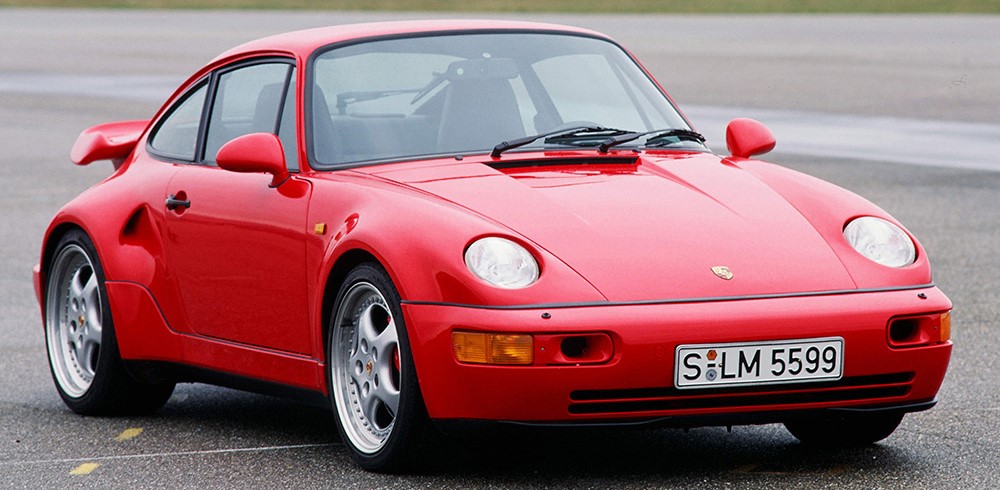
1995: Bi-turbocharging
The 993 series 911 Turbo, presented in 1995, was given a 3.6-litre engine fitted with two small turbochargers, whose performance curve was not dissimilar to a high-displacement naturally aspirated engine. From as low as 2,000 rpm, the engine generated plenty of thrust which changed into impressive, rousing velocity from 3,500 rpm and pressed the occupants into their seats.
In addition to the output that increased to 300 kW (408 hp) and the rise in the maximum torque to 540 Newton metres, the Weissach engineers also aimed to reduce the engine’s acceleration turbo lag to a previously unknown minimum. They achieved this by using two small turbochargers instead of one large one, whereby the low moment of inertia of the smaller blades had the most significant effect.
The two regulated turbines with integrated bypass flap generated a boost pressure of 0.8 bar. The impressive increase in output and engine speed was also due to optimisation of the charge cycle, the high level of efficiency of the two charge air coolers and the knock control system that facilitated running the engine at optimum efficiency

Porsche 911 Turbo (type 993) Highlights
- The 911 Turbo (type 993) saw the first use of a twin-turbocharger, where a smaller exhaust turbocharger installed for each cylinder bank.
- The Turbo had three separate air intakes on the front and additional air slots lower down to the side for brake cooling.
- The rear spoiler was painted entirely in the vehicle colour. Like the Carrera 4 models, the 911 Turbo also had White indicators on the front and Red indicators on the rear.
- Its 3.6-litre twin-turbo engine delivered 408 PS as standard. Power was increased to 430 PS from model year 1996 and to 450 PS from model year 1998.
- In model year 1995, Exclusive manufactured a limited-edition series of 14 units called the 911 Cabriolet Turbo with a particularly large rear spoiler.
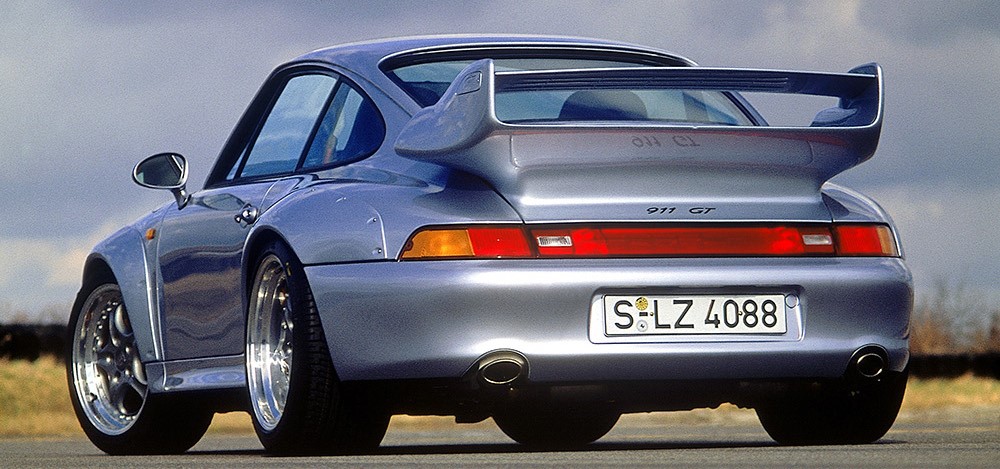
1995 Porsche 911 GT2
The 1995 Porsche 911 GT2, also known as the 993 GT2, is a highly revered model among automotive enthusiasts. The 993 GT2 features prominent wide-body styling with large rear fender flares to accommodate wider tires, a significant rear wing, and front air vents to improve cooling and downforce. Porsche used extensive use of lightweight materials like aluminum and carbon fiber, with features such as a stripped-down interior to reduce weight, resulting in a curb weight of around 2,850 lbs (1,293 kg). High-performance braking system with ventilated and cross-drilled discs and ABS to provide exceptional stopping power with track-oriented suspension setup for improved handling and stability at high speeds. Originally developed to meet homologation requirements for GT2 class racing, the 993 GT2 has a strong racing heritage.
- Model Year: 1995
- Model: 911 GT2 (993 generation)
- Body Style: 2-door coupe
- Layout: Rear-engine, rear-wheel drive (RR layout)
- Engine: 3.6-liter twin-turbocharged flat-six
- Power Output: Approximately 424 hp (316 kW) in its initial version, with later versions reaching up to 450 hp
- Torque: 432 lb-ft (586 Nm)
- Transmission: 6-speed manual
- Top Speed: Around 187 mph (301 km/h)
- 0-60 mph: Approximately 3.9 seconds




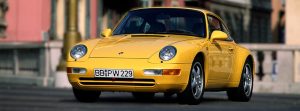
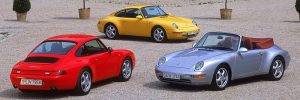
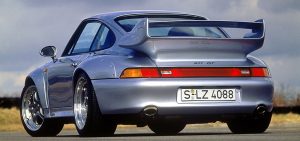
You must be logged in to post a comment.